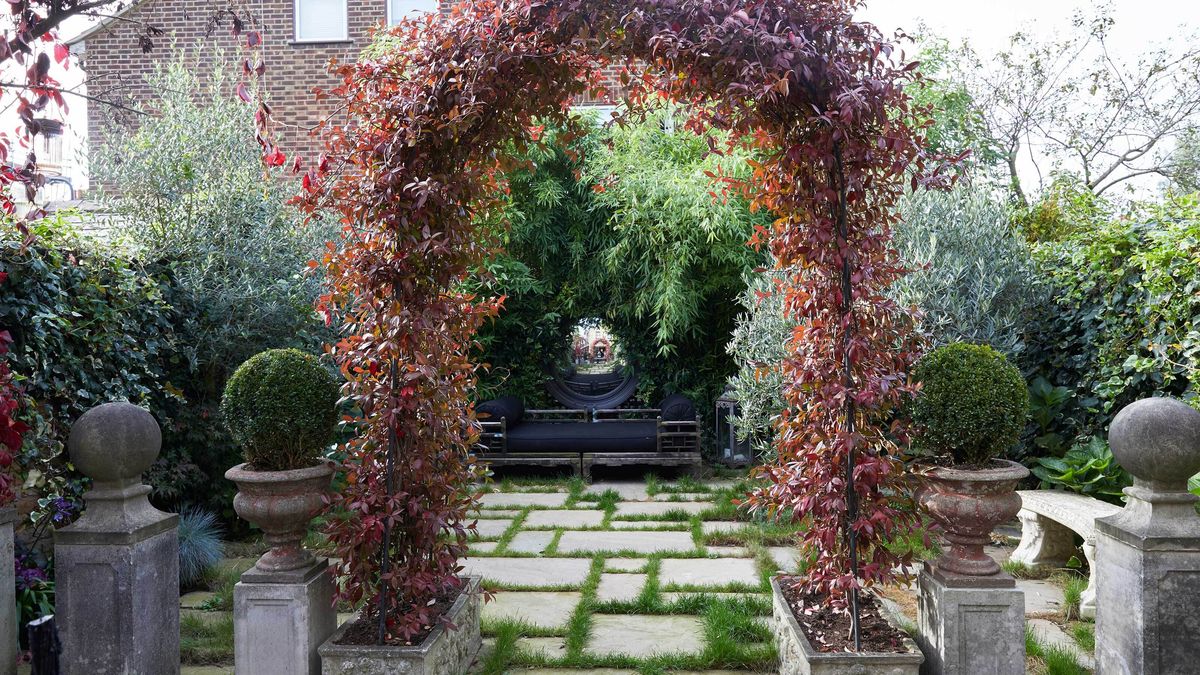Home>Garden Essentials>Why Was American Modernism Behind European Modernism In Landscape Design?


Garden Essentials
Why Was American Modernism Behind European Modernism In Landscape Design?
Modified: March 7, 2024
Explore why American modernism in landscape design lagged behind its European counterpart, with a focus on garden aesthetics and design choices.
(Many of the links in this article redirect to a specific reviewed product. Your purchase of these products through affiliate links helps to generate commission for Storables.com, at no extra cost. Learn more)
Introduction
When it comes to landscape design, American modernism has often been perceived as lagging behind its European counterparts. While European countries like France, Italy, and the Netherlands have a rich history of groundbreaking landscape design movements such as the French formal garden, Italian Renaissance gardens, and Dutch landscape architecture, American modernism in landscape design seems to have taken a back seat.
However, it is important to understand the historical background and various factors that contributed to this disparity. From the influence of European design movements to cultural and economic factors, there are several reasons why American modernism lagged behind European modernism in landscape design.
In this article, we will delve into the reasons behind this discrepancy and shed light on the factors that shaped the landscape design industry in both Europe and America. By examining the historical context and exploring the influence of various factors, we can gain a deeper understanding of why American modernism in landscape design was not as prominent as its European counterpart.
Key Takeaways:
- American modernism in landscape design lagged behind European modernism due to historical, cultural, and economic factors, but has since evolved to embrace regional context, sustainability, and innovative design approaches.
- The differences between American and European modernism in landscape design reflect unique historical, cultural, economic, educational, governmental, and geographical dynamics, shaping the industry in each region.
Read more: Why Are Drummers Behind Glass
Historical Background
To understand the disparity between American and European modernism in landscape design, we must first examine the historical context in which these movements emerged.
Europe has a long-standing tradition of elaborate and meticulously planned gardens dating back centuries. Landscapes like the expansive French formal gardens of Versailles and the picturesque Italian Renaissance gardens have served as inspiration for generations of European landscape designers.
On the other hand, the history of landscape design in America is relatively shorter. In its early years, America was primarily focused on establishing settlements and developing the infrastructure of a new nation. The concept of landscape design was not a high priority during this period.
It wasn’t until the late 19th century that landscape architecture began to gain recognition as a profession in the United States. With the increasing urbanization and industrialization of American cities, there arose a need for urban parks, public spaces, and planned residential communities.
This led to the emergence of the City Beautiful movement in the late 19th and early 20th centuries, which sought to create aesthetically pleasing urban environments with well-designed parks and landscaped spaces. However, this movement was heavily influenced by the formal European design traditions, rather than developing a distinct American modernist approach.
It wasn’t until the mid-20th century that American modernism in landscape design started to gain traction. Influenced by the modernist architectural movement, landscape architects such as Thomas Church and Garrett Eckbo pioneered a new approach to landscape design characterized by clean lines, functional spaces, and the integration of indoor and outdoor living.
Despite this development, American modernism in landscape design still had a way to go before catching up to the established European modernist movements in terms of recognition and influence.
Now that we have established the historical background, let’s explore the factors that contributed to the disparity between American and European modernism in landscape design.
Influence of European Design Movements
One of the key factors contributing to the lag of American modernism in landscape design was the strong influence of European design movements. European countries, with their rich history in landscape design, had well-established traditions and influential figures in the field.
The likes of André Le Nôtre, who designed the magnificent gardens of Versailles, and Gertrude Jekyll, known for her influential work in English garden design, had a profound impact on the development of landscape design in Europe. These design movements, such as the French formal garden and the English picturesque garden, laid the foundation for European landscape design.
American landscape designers of the time took inspiration from these European design movements, often replicating or adapting their styles. The influence of European design, while not inherently negative, led to a lack of originality and innovation in American modernist landscape design.
Moreover, European design movements were grounded in centuries of cultural and historical context. The landscapes and gardens in Europe were often influenced by the grandeur of royalty, aristocracy, and classical traditions. In contrast, America was a relatively young nation, lacking the same historical depth and cultural influences as Europe.
As a result, American landscape designers often struggled to create a distinctly American modernist style that could rival the European design movements. They were caught in a dilemma of embracing the established European design principles or forging their own path.
It wasn’t until the later part of the 20th century that American landscape architects began to break free from the European influence and develop a more unique and innovative approach to landscape design.
However, it is important to note that while European influence played a significant role in the lag of American modernism, it also provided inspiration, knowledge, and techniques that were essential for the growth and development of the profession.
With this historical context in mind, let’s explore other factors that contributed to the disparity between American and European modernism in landscape design.
Cultural Factors
Cultural factors also played a significant role in the difference between American modernism and European modernism in landscape design. Cultural attitudes and values shape the way people perceive and interact with their surroundings, including the design of landscapes.
In Europe, there has been a longstanding appreciation for art, beauty, and aesthetics. The notion of creating visually stunning and harmonious landscapes has been ingrained in European culture for centuries. European societies have a deep-rooted connection to their landscapes and gardens, viewing them as extensions of their cultural heritage and identity.
On the other hand, American culture has historically been more focused on progress, pragmatism, and functionality. The de-emphasis on aesthetics in early American society meant that landscape design was often viewed as a secondary concern, if considered at all. The natural landscape of America was often seen as wild and untamed, needing to be tamed and shaped for practical purposes.
This cultural mindset had an impact on the development of American modernism in landscape design. The emphasis on functionality and practicality sometimes overshadowed the importance of aesthetics in shaping the built environment.
However, cultural attitudes towards landscape design did gradually shift in America. As cities grew, there was a realization that well-designed parks and public spaces contribute to the quality of life and community well-being. This shift in cultural values led to the rise of landscape architecture as a respected profession and increased recognition of the importance of aesthetically pleasing landscapes.
Today, American society has a greater appreciation for the aesthetic and artistic aspects of landscape design. However, the cultural legacy of prioritizing functionality and practicality during the developmental years of America still influences the design approach to some extent.
It is important to note that cultural factors are not inherently positive or negative but offer valuable insights into understanding the disparities between American and European modernism in landscape design.
Now, let’s explore the economic factors that contributed to the lag of American modernism in landscape design.
Economic Factors
Economic factors played a significant role in the difference between American and European modernism in landscape design. The economic conditions and resources available in each region influenced the development and advancement of landscape design practices.
Europe, with its long-established societies and wealthy aristocracy, had greater financial resources available for the creation and maintenance of grand, elaborate landscapes. The European nobility had the means to invest in large-scale garden projects, employing skilled gardeners and designers to bring their visions to life. This financial stability allowed for the cultivation of intricate designs and the use of high-quality materials.
In contrast, America was a young nation that underwent rapid industrialization and urbanization. The economic focus was primarily on infrastructure development, such as roads, railways, and buildings, rather than on landscape design. The limited financial resources allocated to landscape projects meant that American designers had to work within tight budgets and constraints.
The economic conditions in America also resulted in different societal priorities. The emphasis was on practicality and functionality rather than the creation of elaborate, ornamental landscapes. This pragmatic mindset shaped the landscape design industry during its formative years.
However, it is crucial to note that economic factors are not solely responsible for the lag of American modernism. As the American economy grew stronger in the mid-20th century, there was an increase in investment in landscape design. This allowed for the development of more innovative and modernist approaches to landscaping.
Furthermore, economic factors have also led to the evolution of American modernism in landscape design. The emphasis on sustainability and cost-effectiveness in contemporary landscape design reflects the economic realities of the time.
Next, let’s explore the role of education and training in shaping the differences between American and European modernism in landscape design.
American modernism in landscape design was behind European modernism due to factors such as a slower acceptance of modernist ideas, a focus on traditional styles, and a lack of influential figures promoting modernism in the early 20th century.
Read more: Why Landscaping Is Important
Education and Training
Education and training are crucial factors that contribute to the development of any profession, including landscape design. The differences in educational systems and training opportunities between America and Europe had a significant impact on the evolution of landscape design in both regions.
In Europe, there has been a long-standing tradition of formal education in landscape design. Many European countries have renowned institutions that offer specialized programs in landscape architecture and garden design. These educational institutions provide comprehensive training, covering various aspects of landscape design, including horticulture, engineering, and artistic principles.
The European education system provides aspiring landscape designers with the opportunity to gain in-depth knowledge and practical skills necessary for the profession. This focus on education and training ensures that designers are well-equipped to create innovative and aesthetically pleasing landscapes.
On the other hand, the education and training opportunities in landscape design were more limited in America during its early years. In the late 19th century, landscape architecture programs began to emerge in American universities, but they were often integrated into broader architecture or engineering programs.
It wasn’t until the early 20th century that dedicated landscape architecture programs started to gain recognition in American universities. However, the development of these programs was still in its infancy compared to their European counterparts.
Furthermore, the curriculum of American landscape architecture programs initially focused on traditional design principles influenced by the European design movements. This contributed to the perpetuation of European design styles in American landscape architecture.
However, as the profession of landscape architecture grew in America, there was an increased emphasis on developing a more distinct and modernist approach. American designers, such as Ian McHarg and Lawrence Halprin, played a pivotal role in shaping the curriculum and pedagogy of landscape architecture programs in the United States.
Today, the landscape architecture programs in America have evolved to offer a comprehensive education that fosters creative thinking, sustainable practices, and interdisciplinary collaboration.
The differences in educational systems and training opportunities between America and Europe have influenced the approaches to landscape design in both regions. However, advancements in education and training have paved the way for the growth of American modernism in landscape design.
Now, let’s explore the role of government policies and funding in shaping the landscape design industry.
Government Policies and Funding
Government policies and funding have a significant impact on the development and growth of any industry, including landscape design. The role of government in shaping the landscape design industry varies between America and Europe, which has contributed to the disparity in modernism between the two regions.
In Europe, many countries have a long history of active government involvement in landscape design. Governments have played a crucial role in the preservation and restoration of historical landscapes, as well as the creation of new public spaces and parks. This support and funding have allowed European landscape designers to push the boundaries of innovation and create groundbreaking designs.
On the other hand, in America, government involvement in landscape design has historically been more limited. While there have been notable public projects, such as the development of national parks, the level of government support and funding for landscape design has been relatively lower compared to Europe.
Government policies and funding influence the priorities and resources allocated to landscape design projects. In Europe, where governments have recognized the cultural and economic value of landscapes, there is often dedicated funding available for landscape design initiatives. This financial support enables designers to experiment, take risks, and create cutting-edge designs.
In America, landscape design projects are often reliant on private funding or philanthropic initiatives. This can place limitations on the scale and scope of projects, as well as the ability to take risks and be innovative. As a result, American modernism in landscape design may have been constrained by the availability of government support and funding.
However, it is important to acknowledge that government policies and funding have evolved over time in both America and Europe. As the importance of well-designed landscapes becomes more recognized, there has been an increase in government support for landscape design projects in America.
Additionally, initiatives such as urban revitalization programs, environmental conservation efforts, and sustainable development strategies have led to greater government involvement and funding in landscape design across both regions.
The role of government policies and funding in shaping the landscape design industry is complex and multifaceted. While the variations between American and European approaches exist, the increasing recognition of the value of landscapes is driving changes in government support and funding for both regions.
Finally, let’s explore the role of geographical factors in contributing to the differences between American and European modernism in landscape design.
Geographical Factors
Geographical factors play a significant role in shaping the differences between American and European modernism in landscape design. The natural landscapes, climates, and geographical characteristics of each region have influenced the design approaches and possibilities in the field of landscape architecture.
Europe benefits from a diverse range of natural landscapes, including mountains, coastlines, forests, and fertile plains. This diversity provides European landscape designers with a wealth of natural elements to incorporate into their designs. The varied topography and climatic conditions allow for the creation of unique and multifaceted landscapes.
In contrast, the geographical characteristics of America are vast and diverse, with different regions featuring their own distinct landscapes and climates. From the lush forests of the Pacific Northwest to the arid deserts of the Southwest, the geographical diversity of America presents both opportunities and challenges for landscape designers.
The vastness of America’s landscape has led to the development of regional design styles and approaches. For example, the desert landscape of the American Southwest has influenced the use of native plants and water-conserving design principles. Similarly, the coastal landscapes of the East and West Coasts have inspired designs that embrace the natural beauty and integration with water bodies.
Geographical factors also influence the availability of resources and materials for landscape design. Europe has a long history of utilizing locally sourced materials, such as stone, timber, and plants, in their landscape designs. This organic integration of materials from the surrounding environment contributes to the harmonious and naturalistic look often associated with European landscapes.
In America, the availability of resources varies significantly depending on the region. For instance, the use of native plants and materials may differ between the coastal areas and the inland regions. The vast expanse of America also means that transportation costs for materials can be high, impacting the feasibility of certain design choices.
Climate is another important geographical factor that influences landscape design. The climatic conditions, including temperature, rainfall, and sunlight, determine the types of plants that can thrive in a given region. American landscape designers must take into account the specific climatic conditions of their project site and select plant species that are well-suited to withstand these conditions.
Overall, the geographical factors of each region have influenced the design approaches and possibilities in landscape architecture. The diverse landscapes, climates, and availability of resources shape the distinctiveness of American and European modernism in landscape design.
Now, let’s conclude our exploration of the reasons behind the disparity between American and European modernism in landscape design.
Conclusion
The difference between American and European modernism in landscape design is a product of various factors that have influenced the development and evolution of the profession in each region. From the historical background to the influence of European design movements, cultural factors, economic conditions, education and training, government policies and funding, and geographical characteristics, these factors have shaped the landscape design industry in their own unique ways.
The historical context plays a significant role, with Europe having a long-standing tradition of elaborate and meticulously planned landscapes, while America, as a young nation, focused more on infrastructure development. The influence of European design movements, such as the French formal garden and Italian Renaissance gardens, has also been prominent in shaping the landscape design industry in America.
Cultural factors have contributed to the differences in design approaches, with Europe’s strong appreciation for aesthetics compared to America’s historical focus on functionality and pragmatism. Economic factors, including financial resources and societal priorities, have also influenced the development of landscape design in each region.
Education and training have played a crucial role as well, with Europe having a long history of formal education in landscape design, while America experienced a later development of dedicated landscape architecture programs. Government policies and funding have varied between the regions, with Europe often providing more support and funding for landscape design initiatives.
Finally, geographical factors, such as diverse natural landscapes, climates, and availability of resources, have shaped the possibilities and design approaches in both America and Europe.
While American modernism in landscape design may have initially lagged behind its European counterparts, the profession has evolved and grown over time. The American landscape architecture industry has now developed its own unique and innovative design approaches that embrace regional context, sustainability, and the integration of nature and built environments.
It is important to recognize that landscapes and design movements are constantly evolving, and the gap between American and European modernism in landscape design continues to narrow as the profession matures and new ideas emerge.
Ultimately, the differences between American and European modernism in landscape design are a reflection of the unique historical, cultural, economic, educational, governmental, and geographical dynamics that have shaped the industry in each region. By understanding and appreciating these factors, we can create a more inclusive and diverse global landscape design community that draws inspiration from various traditions and perspectives.
Frequently Asked Questions about Why Was American Modernism Behind European Modernism In Landscape Design?
Was this page helpful?
At Storables.com, we guarantee accurate and reliable information. Our content, validated by Expert Board Contributors, is crafted following stringent Editorial Policies. We're committed to providing you with well-researched, expert-backed insights for all your informational needs.















0 thoughts on “Why Was American Modernism Behind European Modernism In Landscape Design?”